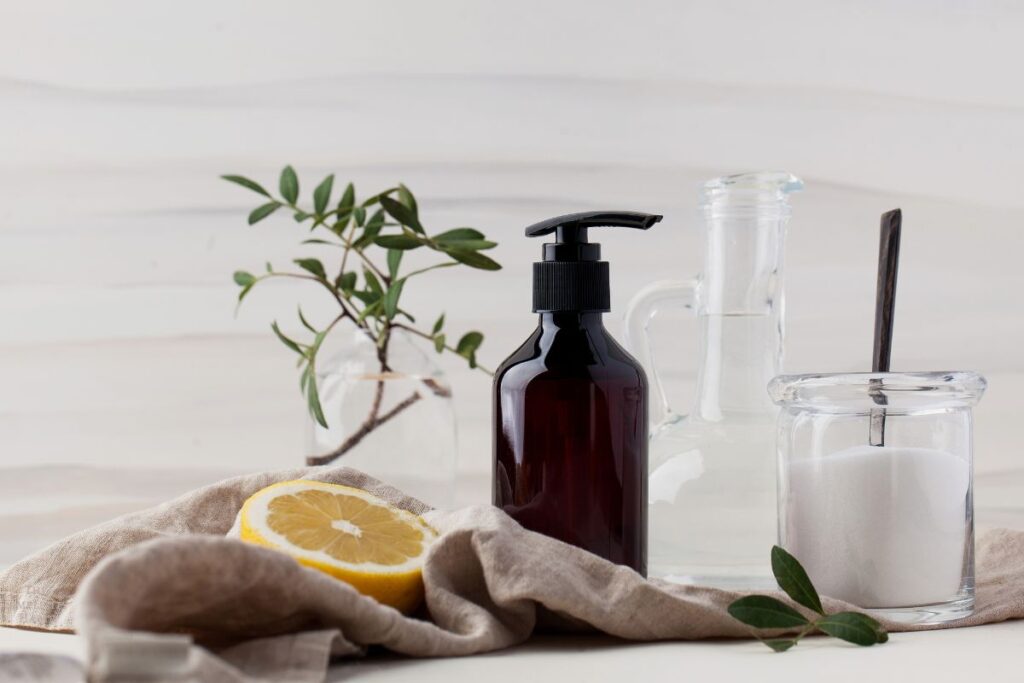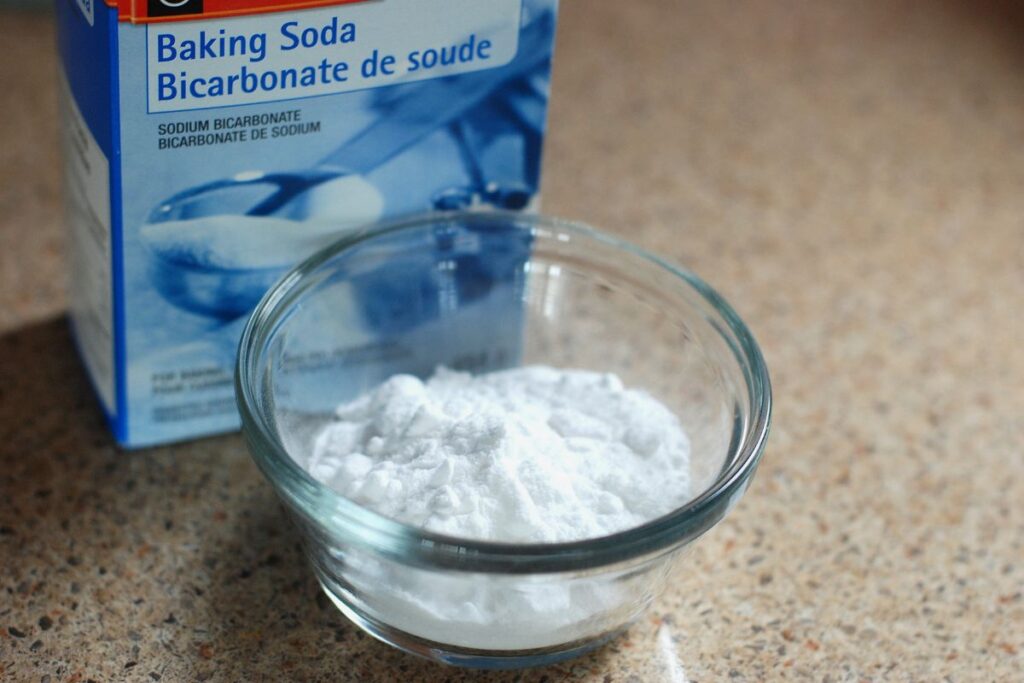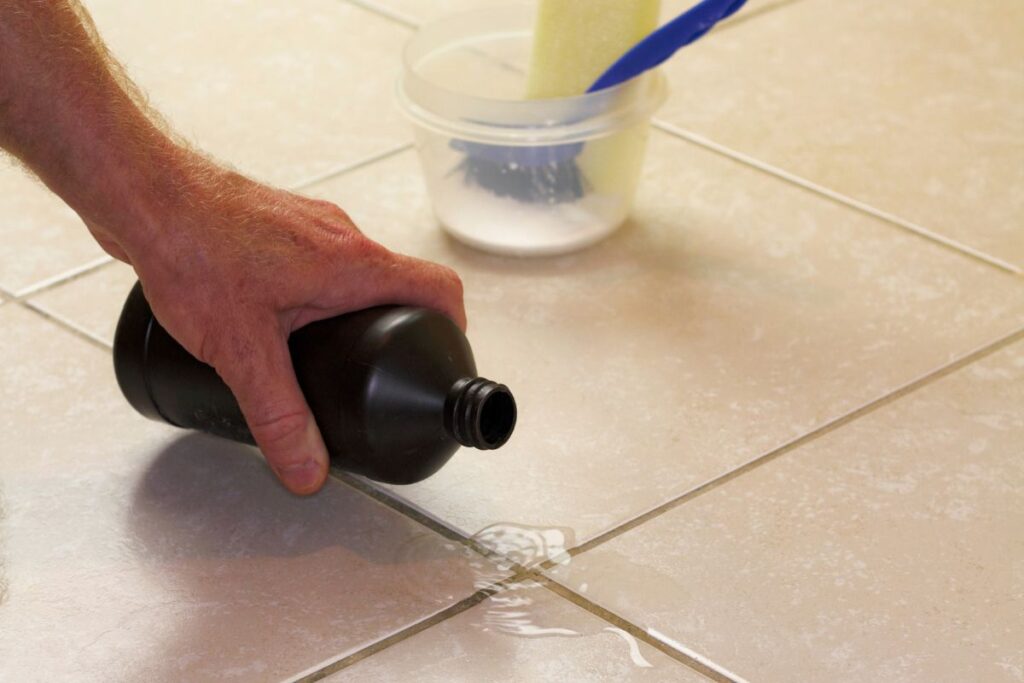Inside: Use this minimalist cleaning supply checklist to see if you already have these six essential items on hand.
A guest post by Cora Gold
If you enjoy a sparkling clean home, you might find yourself tempted to buy every trendy new product that hits the cleaning supply aisle.
There is always a new product on the market that claims to be a magical solution, but in reality, many products do the same thing.
You don’t need to overstuff your cabinets with a different product for every area in your home.
When you buy only the essentials, you can save money, avoid cluttering your home, limit toxins, and reduce packaging waste from buying too many bottles.
Here’s a minimalist cleaning supply checklist to help you stick to the necessities and avoid overbuying.

The Tools of the Trade
There are a variety of ways to make cleaning feel less like a chore. Before we talk about the minimalist cleaning supply checklist, let’s take a look at the tools of the trade.
Your mind might automatically turn to various chemicals when you think of cleaning supplies. However, the right tools help you get your scrubbing job done quickly and efficiently — who wants to spend more time cleaning than necessary?
They can even protect your safety, preventing injuries from trying to reach too high or navigating slippery surfaces.
Here, you want a few high-quality items. For example, many people cut up old T-shirts for cleaning rags, which are ideal for some surfaces.
However, you also want a stash of microfiber cloths, as the terry edge lets them shine surfaces without scratching the finish. Their design also helps them trap more dust when not using an accompanying product.

What tools should you stock your cleaning supply closet with? Here are the essentials:
- Feather duster — these are perfect for dusting mirrors and picture frames with a delicate touch that doesn’t leave them hanging crooked.
- Rags — old, cut-up clothing is fine for the mop and bucket, but you should add a few microfiber cloths for delicate surfaces.
- Scrub brushes in various sizes, including a small one for grout — an old toothbrush works, too.
- Sponges — silicone models are naturally antimicrobial, so you don’t have to toss them until they wear out.
- Bucket.
- Broom.
- Mop.
- Vacuum —Shark makes some great ones with good warranties.
- Extender tools.
- Toilet brush.
- Gloves.
For the DIYer
Perhaps you’re skeptical of store-bought commercial cleansers as you prefer a clean, green approach. If so, you’re in luck.
You don’t have to buy many products to complete your minimalist cleaning supply checklist and those you do won’t set you back much cash. From there, you can make everything you need.

Minimalist Cleaning Supply Checklist: 6 Helpful Items to Have On Hand
It’s quite possible you may already have all of the items on the minimalist cleaning supply checklist in your home. In which case, great! No need to get anything further to clean your home. Here are the 6 essentials.
1. White, Distilled Vinegar
Plain white, distilled vinegar is your go-to base for several DIY cleaner formulations. The magic ingredient is acetic acid, a disinfectant that kills many — although not all — bacteria and viruses.
How much it destroys depends on the formulation you pick. You might have noticed “full strength” and “double strength” vinegar on store shelves. What does that mean?
- Regular white vinegar: 5% acetic acid
- Full strength: 6% acetic acid
- Double strength: 10% acetic acid
Therefore, if you seek the ultimate germ-busting power, you should opt for double-strength vinegar, often available at hardware stores like Ace if not on your regular grocer’s shelves.
While you can mix vinegar with nearly anything else on this list, there are a few caveats:
- Peroxide: Mixing vinegar with hydrogen peroxide creates peracetic acid, irritating your eyes, nose, and throat. It’s okay to alternate wiping surfaces with each product as long as they dry in between.
- Bleach: You should also avoid mixing vinegar with bleach. Doing so creates chlorine gas.
- Castile soap: Vinegar breaks down the oils in Castile, leaving you with a lumpy mess. It’s not dangerous, but it is a pain.

2. Baking Soda
You can use baking soda like you would a commercial cleanser. Make a paste with it and water to scrub anything from your grout to the inside of your oven without chemicals.
You can also sprinkle it over surfaces like your bathtub to help remove stains.
3. Clear Dish Soap
Clear dish soap contains no oils like Castile, making it another excellent base for many all-purpose products. It also works on its own.
For example, those with nonstick pans or appliance parts might want to skip the dishwasher to avoid stripping the coating. Simple handwashing with Dawn’s original liquid or a similar brand will do the trick.
You can also clean your sink with it, making it a two-in-one solution or your kitchen.

4. Hydrogen Peroxide
Here’s another germ-killer that gets many of the nasties vinegar misses. It’s also effective against mold.
Use a 3% solution in a spray bottle on bathroom surfaces and other areas where the fuzzy stuff tends to grow.
5. Castile Soap
The oils in this soap are good for porous surfaces like wood. Mixing this with a bit of olive oil and your favorite essential oil makes a natural furniture polish.
6. Salt
Salt is an abrasive agent when baking soda and water isn’t enough, but you don’t have to worry about scratching a delicate surface. For example, you might add a bit to your oven-cleaning paste if you have tons of baked-on gunk.

For Those Who Prefer Commercial Products
Other people prefer the convenience of commercial products — and that’s okay. You’re still keeping things eco-friendly if you reduce your overall consumption. Furthermore, reading labels helps you select less toxic formulations.
- An all-purpose cleaner: A must for most surfaces.
- A wood-safe polish: If you have wood floors or seating, a wood-safe polish is necessary.
- Goo remover: Brands like Goo Gone remove adhesive left over from tape and sticky substances like tar.
- White, distilled vinegar: Guess what? You can skip the Windex. This stuff works better than any blue stuff for cleaning glass and is less expensive. Pick the 10% formulation for ultimate streak removal.
- Carpet cleaner: For stains. You might also want to add an odor eliminator if you have pet messes.
- Specialty floor cleaner: Flooring surfaces like hardwood need special care beyond your all-purpose cleaner, which can strip the surface.
- Bleach: For killing germs. Remember to never mix bleach with vinegar or ammonia. You should also keep it away from rubbing alcohol. A good rule of thumb is to avoid mixing bleach with anything else to prevent toxic gas formation.
Check out this post for the best cleaning tips from a professional house cleaner.

Create Your Minimalist Cleaning Supply Checklist
If your cleaning cabinet overflows with various formulas, you probably don’t need all of them. Use what you have, then study this list to discern the basics you should keep on hand.
Before you rush out to buy a new product to address that mess, check what you already have. Combine these cleaning supplies with daily cleaning habits and you’ll have your home shining in no time!

Cora Gold is the Editor-in-Chief of Revivalist magazine. She loves writing about family and living life to the fullest. Follow Cora on Twitter, Facebook and Pinterest.
What’s on your minimalist cleaning supply checklist? Let us know your favorite supplies in the comments section.
Sign up on the form below to get weekly tips on decluttering and simplifying sent straight to your inbox! You’ll also receive the free Cleaning Checklist because marking off boxes is fun!


sos pads and comet
I only use Vinegar, Salt, Soda and dish soap plus Essential oils for all my cleaning.